Celebrity Ascent Cruise ship review
Celebrity Ascent, for 3,260 guests, is a big ship marked out like its three Edge-series predecessors, by the golden structure on its starboard bow that carries its Magic Carpet, an open-air platform cantilevered over the ship’s side, up and down 13 decks, from daytime bar to evening restaurant and music venue, even a floating dock for boat tenders to shore.
Britain’s own renowned interior designer Kelly Hoppen is responsible for much of the interior, a subtle – and un-ship-like – rich grey, combined with contemporary art and elegant furniture.
Who is Celebrity Ascent for?

The casual, calm Resort Deck
Celebrity cruises has always offered a smart, carefree environment, stylishly casual rather than baseball cap and shorts. Celebrity Ascent continues that but with a more colourful, up-tempo atmosphere. Centrepoint, rather than a conventional atrium, is the Grand Plaza, a vast sunken nightclub-like bar with walkways on two levels looking down from around the edge. The small, high windows mean there’s a warm, cossetted feel, more like a luxury 24-hour Las Vegas hotel than a cruise ship. There seem to be younger couples than on many cruises and the wide selection of bars and restaurants make it a place to wander each evening. And, of course, there are no water slides or fun parks – this isn’t adults-only but the youthful-minded of all ages enjoy the pools and decks.
What’s on board?
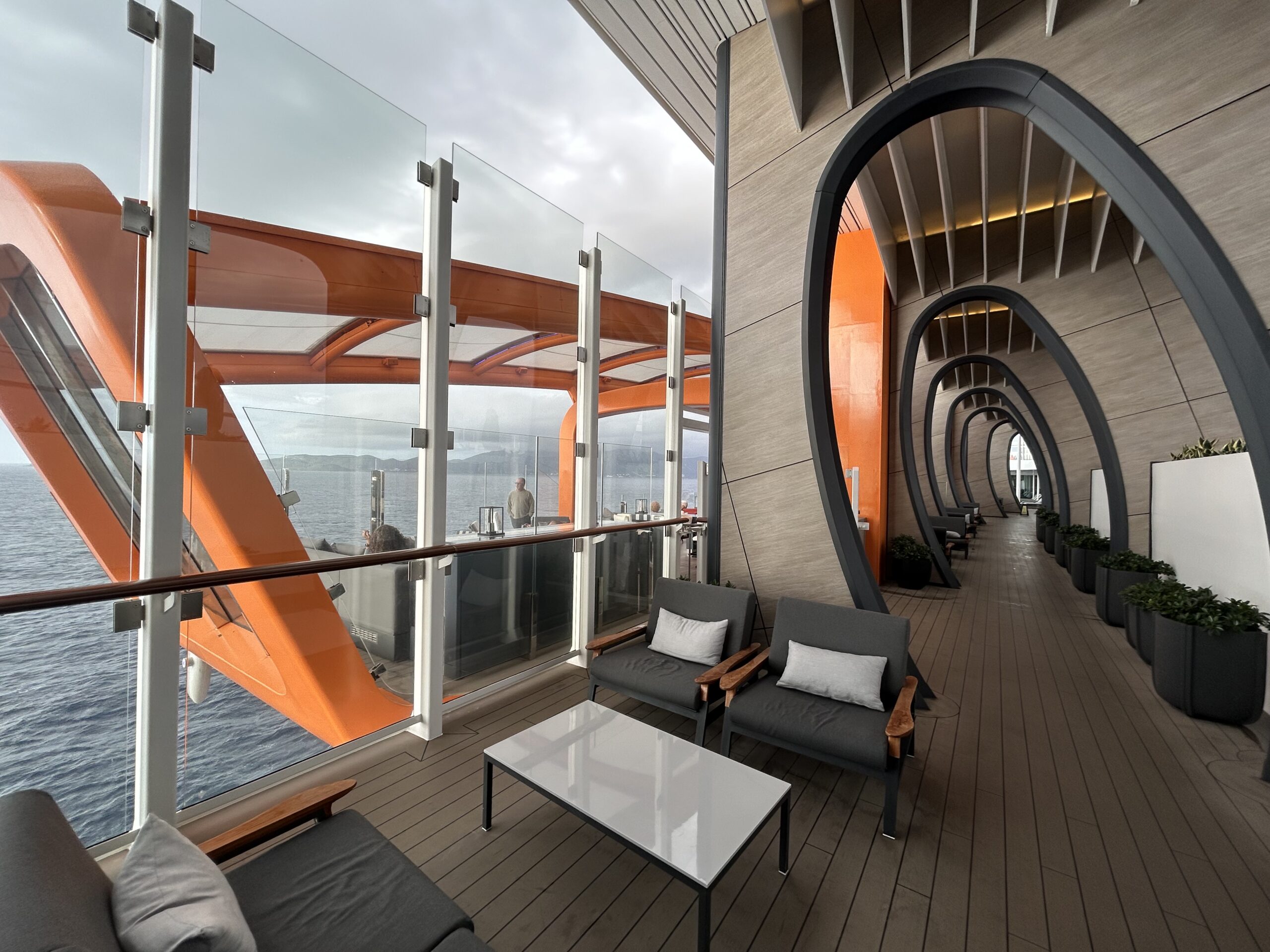
The Magic Carpet seen from one of the contemporary deck spaces
There are special outdoor areas on several levels. The Resort Deck is overseen by a giant chrome octopus and the glass walls give panoramic views. To one side, instead of the regulation upper deck walkway, a curved slope rises from pool level to higher vantage point. Go higher and there’s the Rooftop Garden, a relaxation spot of sofas and sunshades amongst real bushes. Back on the Resort Deck, the Solarium is a ship-wide, glass-roofed, child-free spot with pool, hot tubs and sun loungers with light breakfast and lunch options at the Spa Café. For all the moody, modern décor the ship is full of light – lofty Eden, a bar, show venue, café and light food venue with two-deck glass walls curving around the back of the ship, the daytime Mast bar, more glass walls along with burgers, and the Magic Carpet, an open-air glass box with views of ship as well as the outside world – all places where you can sit with a book with a coffee, a drink or just your thoughts. There’s a spa with plenty of treatment rooms and a panoramic gym curved around the bow.
Your stateroom or suite
 Rooms are decorated in soothing greys, browns, and white, perfectly in tone with the rest of the ship. King-size beds, great showers, and several rooms have conventional balconies. Many more, though, have an ‘Infinite Balcony’ – folding glass doors access a balcony-sized spot with table and chairs but with glass wall, meaning that your balcony can always be part of the room, but when you slide down the top half of the glass wall, your whole room becomes a balcony. There are also some rooms with simply a small window, others with no window at all – when you’re on a cruise with plenty of stops (my nine-night Barcelona to Civitavecchia voyage had six) you’re mostly off-ship or on deck, so no problem. For spa fans, AquaClass staterooms give access to the thermal suite and an exclusive restaurant, Blu, and other spa specials, even your own yoga mat.
Rooms are decorated in soothing greys, browns, and white, perfectly in tone with the rest of the ship. King-size beds, great showers, and several rooms have conventional balconies. Many more, though, have an ‘Infinite Balcony’ – folding glass doors access a balcony-sized spot with table and chairs but with glass wall, meaning that your balcony can always be part of the room, but when you slide down the top half of the glass wall, your whole room becomes a balcony. There are also some rooms with simply a small window, others with no window at all – when you’re on a cruise with plenty of stops (my nine-night Barcelona to Civitavecchia voyage had six) you’re mostly off-ship or on deck, so no problem. For spa fans, AquaClass staterooms give access to the thermal suite and an exclusive restaurant, Blu, and other spa specials, even your own yoga mat.
The Top deck, literally, is The Retreat, a private club-like enclave with lounge and bar, elegant restaurant (Luminae) and sundeck with hot tubs, pool and bar. Seven suite classes culminate in the vast, pale Iconic Suites (biggest in Celebrity’s fleet), perched above the bridge.
Eating
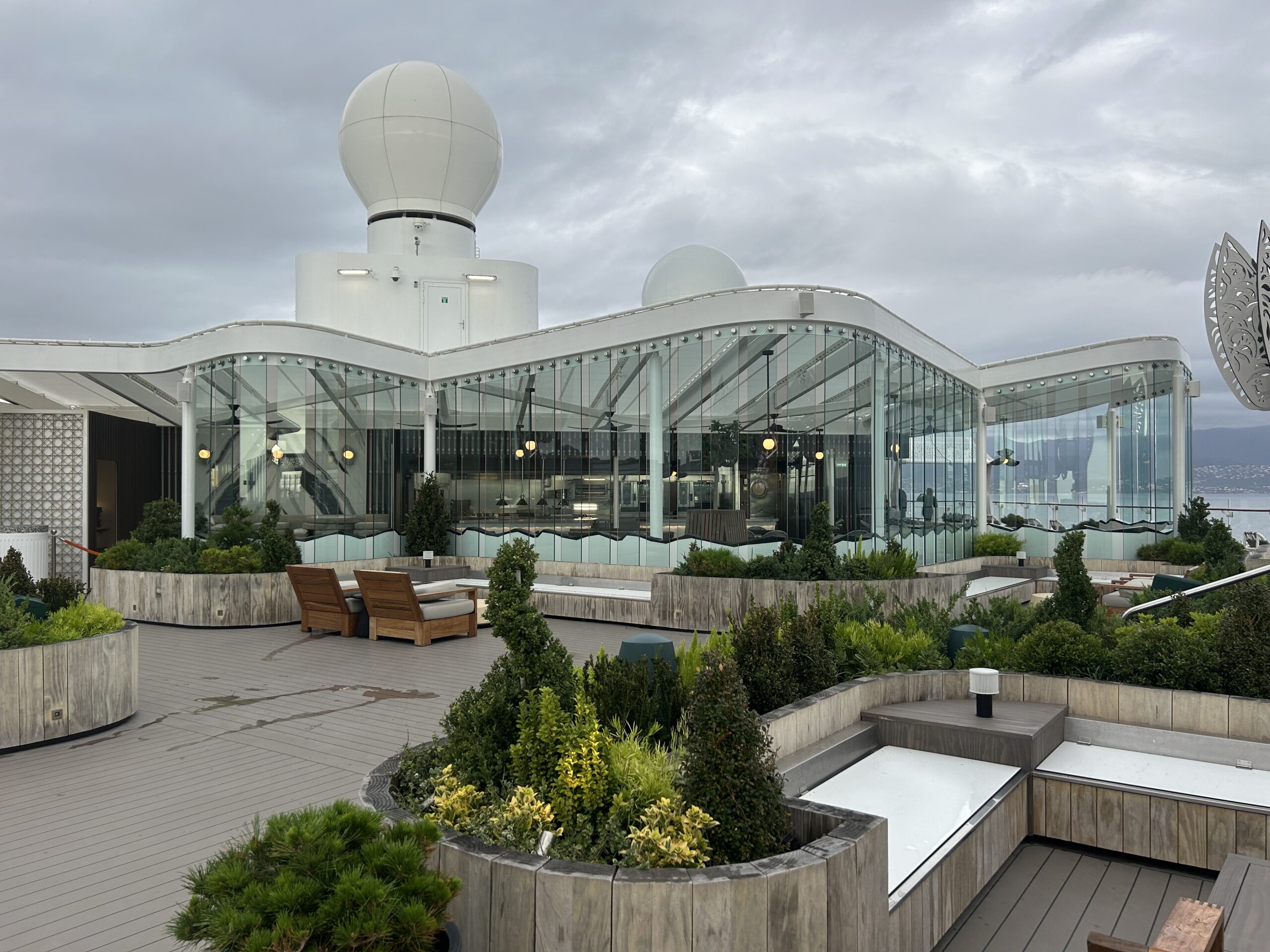
The lofty, leafy setting of the Rooftop Garden Grill
Plenty of options. Unlike many ships, there’s not one, or even two, main restaurants, but four. There’s Cyprus (Greek-leaning Mediterranean cuisine with plentiful seafood) dressed in red and gold, Tuscan (Italian) in sleek, classical black and white, Normandie (French) in Parisian razzamatazz and Cosmopolitan (more conventional international dishes and decor). In mirror image on two floors, each is pleasingly different and comfortingly reassuring – alongside daily speciality dishes are some shared dishes and an always-available section (steak/salmon/chicken). Early dining (mostly Americans), later sitting or come-whenever.
The buffet, Oceanview Grill, is one of cruising’s best, a vast array of cuisines – Mexican, Indian, American and more with special themed nights – plus all the usuals, from roasts to crispy chicken, and lots of salads and vegetarian options. And plenty of choice (including dahl and fried rice) at breakfast.
Plenty more included food at cafes and bars from bow to stern and, like so many ships these days, a bundle of extra-charge venues. The swish Fine Cut Steakhouse is very nice but at $59 plus 20 per cent service (£55) for starter, steak and sides and dessert, it should be. The delightful Rooftop Garden Grill, partially open-air, is an American barbecue house, with a full rack of baby ribs one of the offerings for the $45 charge. All good but whether you feels you’ve benefited to the tune of the extra cash given that you’ve turned your back on excellent food in the main restaurants is debatable – extra-charge restaurants (and there are eight on board) can leave you with an unexpectedly large final bill.
Where to drink
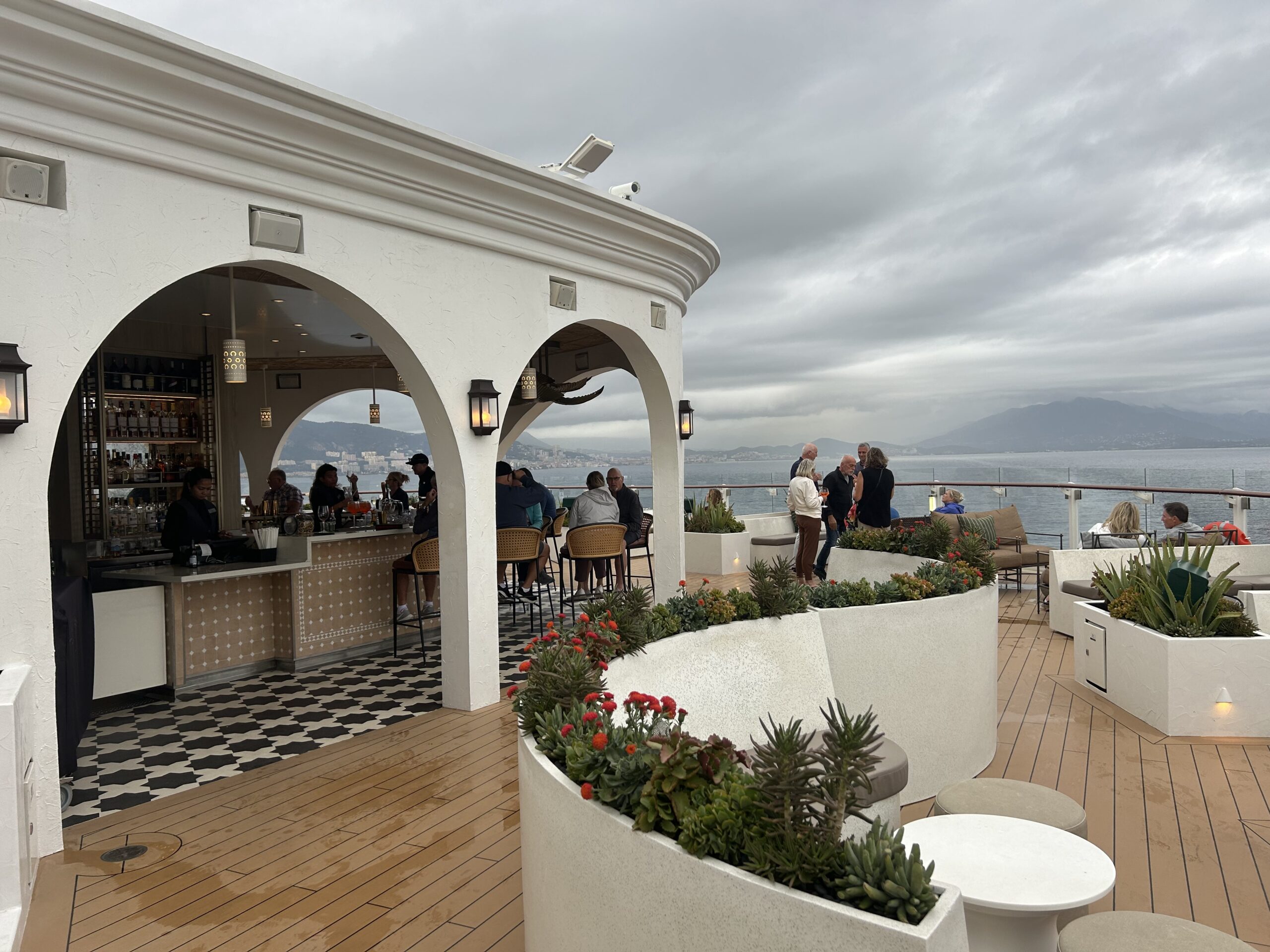
The Sunset Bar, waiting hopefully for the sunset off Corsica
As the sun dips on a summer’s evening in the Med, the Magic Carpet is the spot, hanging over the waves and with gentle, live music. That or the Rooftop Garden, or the Sunset Bar, a hip designer spot, also open-air, at the stern. More low-key but still sunny are the Mast bar and the pool bar, the latter pleasant with early evening music from a live band. And the Oceanview bar at the rear of the buffet has the benefit of open-air tables at the stern combined with the opportunity to pop in for free snacks – the humous and flatbreads are recommended. If you want something more, well, bar-like, the circular Martini Bar at the centre of the Grand Plaza is impressive, often with live music. There’s also Craft Social for good beer and Eden for drinks while you admire both architecture and view.
Entertainment
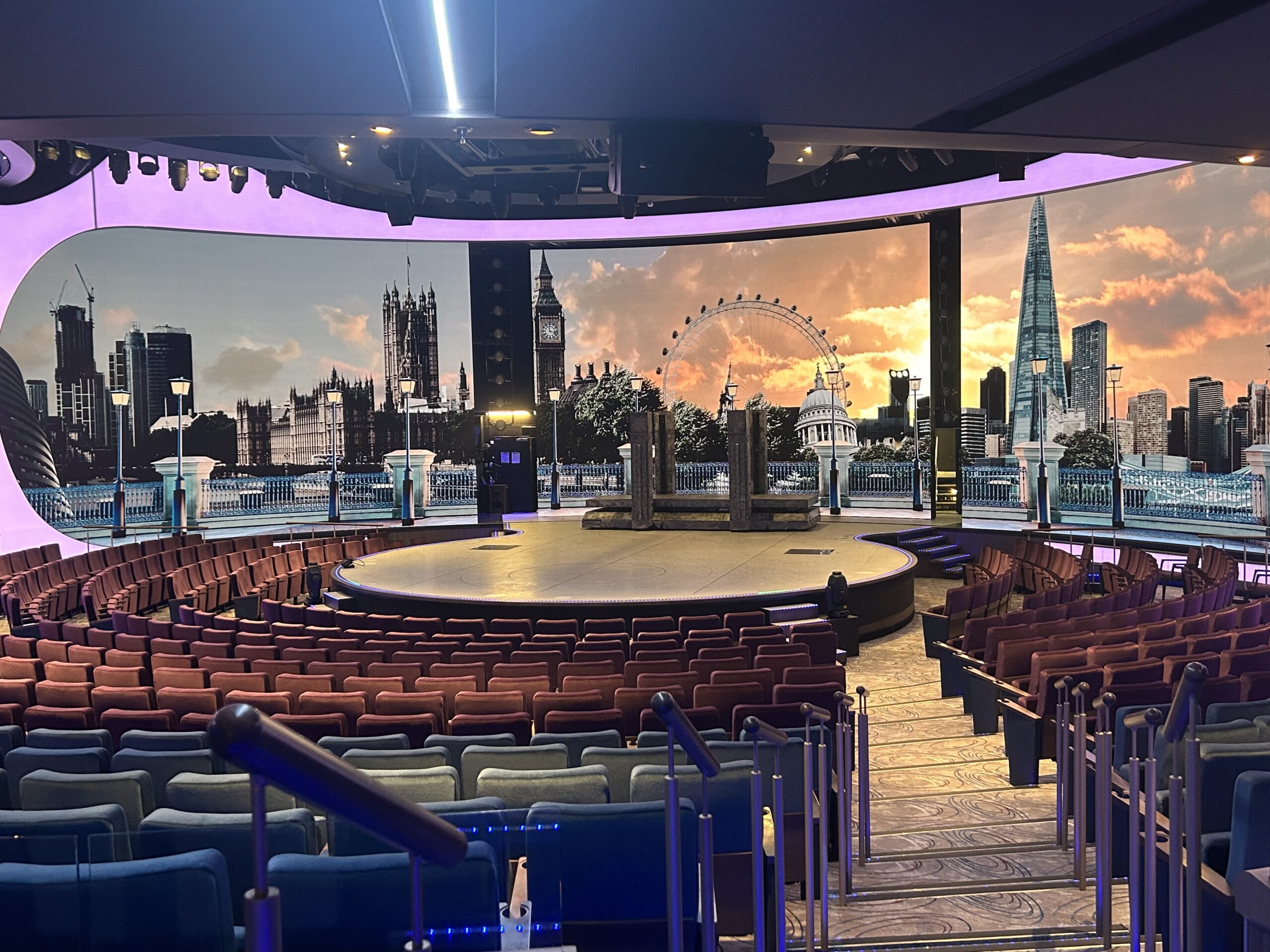
Putting on a show, Celebrity Ascent’s groundbreaking theatre
The theatre is one of the most astonishing venues at sea, a ship-wide, hi-tech dream, with curving backdrop that allows for breathtaking imagery such as the creation that works with the all-singing, all-dancing presentation Bridges, dizzying panoramas from Sydney to San Francisco. There are also separate songs-from-the-shows performances by West End stars Philippa Healey and Sabrina Aloueche, energetic reality-show-style guitar rock and humour from Brit Sandy Grigelis and Brit illusionist and break dancer Magical Bones. There’s flamboyant music in Eden, whether a piano man, a song and dance troupe or jazz while The Club combines theatre and music with shows such as Smoke & Ivories, a Hollywood club-themed show with live performers interweaving with films from the past.
Verdict
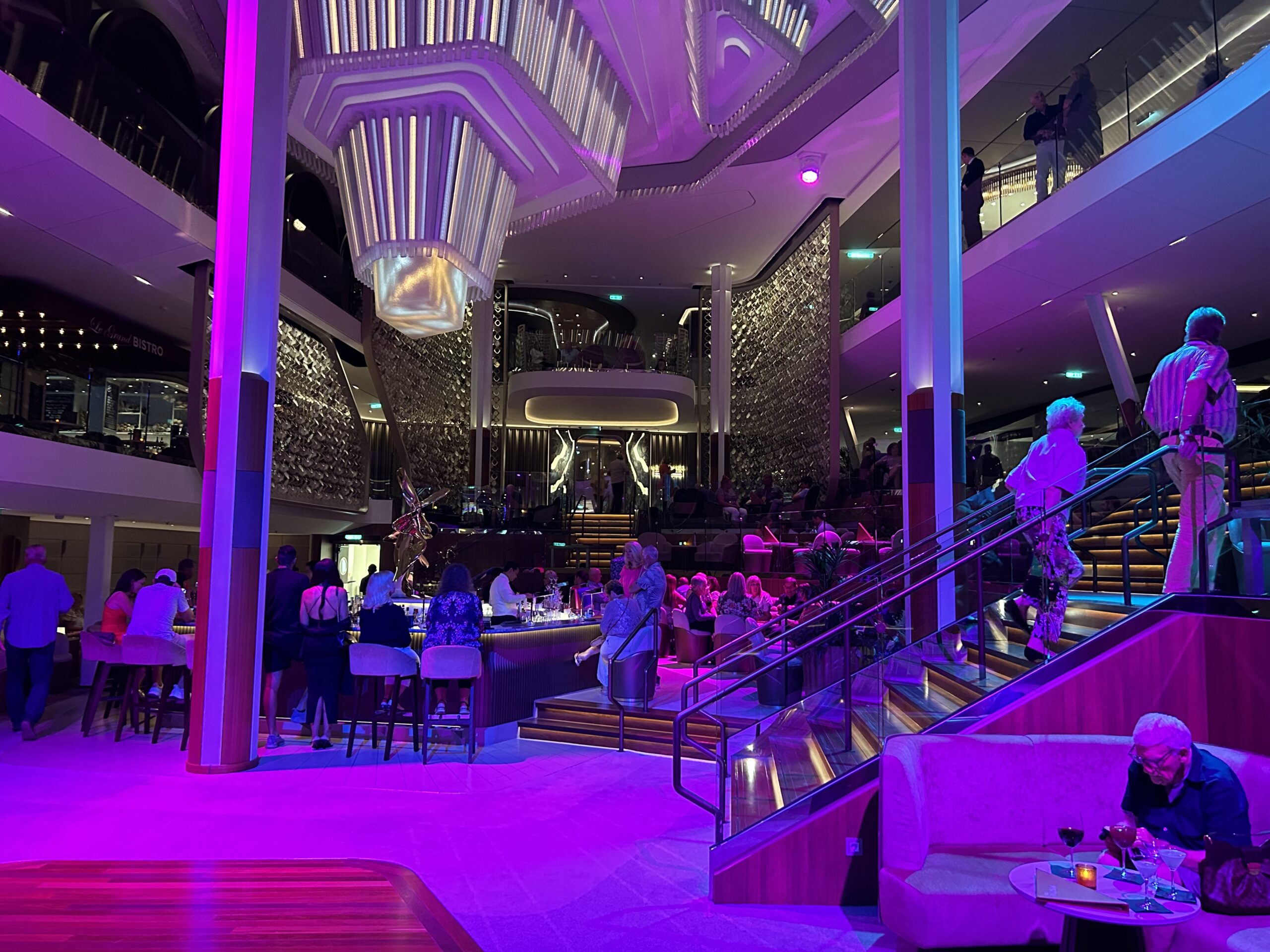
A world apart, evening in the Grand Plaza
For anyone who’s been on a Celebrity cruise, this is the new wave, the style of the past with more music – in many places – and more colour. There’s still plenty of restraint… it’s not a party experience like some Caribbean cruises (even though Celebrity Ascent winters in Florida) but a modern cruise experience. It’s a big ship but with plenty of spots to relax in, and the main restaurants are excellent.
*Celebrity Ascent (celebritycruises.com) will spend the winter sailing from Florida before arriving in Europe in early May 2025 for a summer in the Med, sailing from Barcelona, Civitavecchia and Athens. The 11-night Greece, Italy & Turkey voyage, May 5, 2025, starts at £1,422, cruise-only.
The post Celebrity Ascent Cruise ship review appeared first on The Travel Magazine.


















